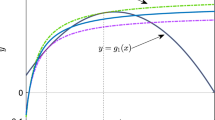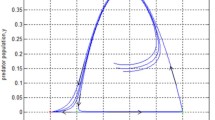Abstract
In this paper, we study a classical two-predators-one-prey model. The classical model described by a system of three ordinary differential equations can be reduced to a one-dimensional bimodal map. We prove that this map has at most two stable periodic orbits. Besides, we describe the bifurcation structure of the map. Finally, we describe a mechanism that leads to bistable regimes. Taking this mechanism into account, one can easily detect parameter regions where cycles with arbitrary high periods or chaotic attractors with arbitrary high numbers of bands coexist pairwise.







Similar content being viewed by others
REFERENCES
J. Alebraheem and Y. Abu-Hasan, ‘‘Persistence of predators in a two predators- one prey model with non-periodic solution,’’ Appl. Math. Sci. 6, 943–956 (2012).
V. Avrutin, L. Gardini, I. Sushko, and F. Tramontana, Continuous and Discontinuous Piecewise-Smooth One-dimensional Maps: Invariant Sets and Bifurcation Structures, Vol. 95 of Nonlinear Science, Series A (World Scientific, Singapore, 2019).
Y. V. Bakhanova, A. O. Kazakov, and A. G. Korotkov, ‘‘Spiral chaos in Lotka–Volterra like models,’’ Zh. Srednevolzh. Mat. Ob-va 19 (2), 13–24 (2017).
G. J. Butler and P. Waltman, ‘‘Bifurcation from a limit cycle in a two predator one prey ecosystem modeled on a chemostat,’’ J. Math. Biol. 12, 295–310 (1981).
R. Devaney, An Introduction to Chaotic Dynamical Systems (CRC, Boca Raton, FL, 2003).
O. Diekmann and M. Kirkilionis, ‘‘Population dynamics: A mathematical bird’s eye view,’’ in Trends in Nonlinear Analysis, Ed. by M. Kirkilionis, S. Krömker, R. Rannacher, and F. Tomi (Springer, Berlin, 2003).
B. Dubey and R. K. Upadhuyay, ‘‘Persistence and extinction of one-prey and two-predators system,’’ Nonlin. Anal.: Model. Control 9, 307–329 (2004).
T. Eirola, A. V. Osipov, and G. Söderbacka, ‘‘Chaotic regimes in a dynamical system of the type many predators one prey,’’ Res. Reports A, No. 386 (Helsinki Univ. Technol., Helsinki, 1996).
T. Eirola, A. V. Osipov, and G. Söderbacka, ‘‘On the appearance of chaotic regimes in one dynamical system of type two predators—one prey,’’ Actual Probl. Mod. Math., Boxitogorsk 1, 39–70 (1996).
A. Farajzadeh, M. H. R. Doust, F. Haghighifar, and D. Baleanu, ‘‘The stability of Gauss model having one-prey-and-two-predators,’’ Abstr. Appl. Anal. 2012, 219640 (2012).
W. Façanha, B. Oldeman, and L. Glass, ‘‘Bifurcation structures in two-dimensional maps: The endoskeletons of shrimps,’’ Phys. Lett. A 377, 1264–1268 (2013).
J. Gallas, ‘‘Dissecting shrimps: Results for some one-dimensional physical models,’’ Phys. A (Amsterdam, Neth.) 202, 196–223 (1994).
V. Hadžiabdić, M. Mehuljić, and J. Bektešević, ‘‘Lotka–Volterra model with two predators and their prey,’’ TEM J. 6, 132–136 (2017).
C. S. Holling, ‘‘The components of predation as revealed by a study of small-mammal predation of the European pine sawfly,’’ Can. Entomol. 91, 293–320 (1959).
S. Hsu, ‘‘Limiting behaviour for competing species,’’ SIAM J. Appl. Math. 34, 760–763 (1978).
S. Hsu, S. Hubell, and P. Waltman, ‘‘Competing predators,’’ SIAM J. Appl. Math. 35, 617–625 (1978).
S. Hsu, S. Hubell, and P. Waltman, ‘‘A contribution to the theory of competing predators,’’ Ecol. Monogr. 48, 337–349 (1978).
J. Keener, ‘‘Oscillatory coexistence in the chemiostat: A codimension two unfolding,’’ SIAM J. Appl. Math. 43, 1005–1018 (1983).
M. Liu and P. S. Mandal, ‘‘Dynamical behavior of a one-prey two-predator model with random perturbations,’’ Commun. Nonlin. Sci. Numer. Simul. 28, 123–137 (2015).
M. C. Montano and B. Lisena, ‘‘A diffusive two predators-one prey model on periodically evolving domains,’’ Math. Methods Appl. Sci. (2021, in press).
A. V. Osipov and G. Söderbacka, ‘‘Poincaré map construction for some classic two predators—one prey systems,’’ Int. J. Bifurc. Chaos Appl. Sci. Eng. 27, 1750116 (2017).
D. F. M. Oliveira, M. Robnik, and E. Leonel, ‘‘Shrimp-shape domains in a dissipative kicked rotator,’’ Chaos 21, 043122 (2011).
N. Samardzija and L. D. Greller, ‘‘Explosive route to chaos through a fractal torus in a generalized Lotka–Volterra model,’’ Bull. Math. Biol. 50, 465–491 (1988).
D. Savitri, A. Suryanto, W. Kusumawinahyu, and Abadi, ‘‘A dynamics behaviour of two predators and one prey interaction with competition between predators,’’ IOP Conf. Ser.: Mater. Sci. Eng. 546, 052069 (2019).
D. Singer, ‘‘Stable orbits and bifurcations of maps of the interval,’’ SIAM J. Appl. Math. 35, 260–267 (1978).
H. Smith, ‘‘The interaction of steady state and Hopf bifurcations in a two-predator-one-prey competition model,’’ SIAM J. Appl. Math. 42, 27–43 (1982).
G. J. Söderbacka and A. S. Petrov, ‘‘Review on the behaviour of a many predator—one prey system,’’ Dinam. Sist. 9 (37), 273–288 (2019).
R. Stoop, S. Martignoli, P. Benner, and Y. Uwate, ‘‘Shrimps: Occurrence, scaling and relevance,’’ Int. J. Bifurc. Chaos 22, 1230032 (2012).
A. Wikan and Ø. Kristensen, ‘‘Prey-predator interactions in two and three species population models,’’ Discrete Dyn. Nat. Soc. 2019, 9543139 (2019).
ACKNOWLEDGMENTS
Authors dedicate the paper to the memory of Gennadiy Alexeevich Leonov.
Funding
Viktor Avrutin was supported by DFG, AV 111/2-2. Sergey Kryzhevich was supported by Gdańsk University of Technology by the DEC 14/2021/IDUB/I.1 grant under the Nobelium—‘‘Excellence Initiative—Research University’’ program.
Author information
Authors and Affiliations
Corresponding authors
Additional information
(Submitted by S. Yu. Pilyugin)
Rights and permissions
About this article
Cite this article
Kryzhevich, S., Avrutin, V. & Söderbacka, G. Bistability in a One-Dimensional Model of a Two-Predators-One-Prey Population Dynamics System. Lobachevskii J Math 42, 3486–3496 (2021). https://doi.org/10.1134/S1995080222020135
Received:
Revised:
Accepted:
Published:
Issue Date:
DOI: https://doi.org/10.1134/S1995080222020135




